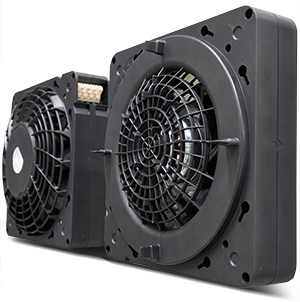TOOL-FREE HANDLING
The previous generation of fan-and-filter units was already designed for tool-free installation and maintenance. Now, the mechanical components have been completely redesigned to allow for tool-free handling. The new design boasts snap-in hooks that click reliably into place during installation and an opening mechanism for changing the filter that is even more user-friendly than before. Tried-and-tested features, such as the simple way of changing the direction of airflow and flexible positioning of the electrical connection, have been retained. Besides the mechanics, the Rittal design has also been updated. The louvres of the grille on the new fans run vertically – while the protection category has, of course, been maintained.
SPEED CONTROL AND FAN MONITORING
Rittal fan-and-filter units are available in five sizes and eight air throughput classes ranging from 20 m³/h to 1,160 m³/h. The AC/DC models have been kept simple, while the EMC versions comply with special requirements relating to the electromagnetic shielding of enclosures. EC fan-and-filter units with brushless DC motors boasting the highest level of efficiency for fans were launched onto the market in 2012. There’s an additional plus point, too – thanks to EC technology, speed control and fan monitoring via an analogue interface are possible. This means the temperature is controlled in line with actual needs – a smart function that saves energy and extends the service life (see box about “green facts”). The new generation offers all this and more. Additional benefits include wide-range input (100–240 V) and a ModBus interface that supports monitoring, control and an alarm function.
ACTIVE COOLING FUNCTION
Every EC fan-and-filter unit that is covered by the Rittal IoT Interface provides information about status, capacity utilisation, operating hours and energy consumption, along with many other functions, too. For example, in a bayed enclosure suite with several fan-and-filter units, temperature sensors can be incorporated at the most critical points and assigned to the respective fan-and-filter unit via the Rittal IoT Interface. If the temperature unexpectedly rises above the alarm threshold, the plant operator is notified and the fan-and-filter unit’s emergency cooling function is activated. The fan speed is ramped up to the maximum – which means an increase in the air throughput of between 16 and 40 percent, depending on the model. It will therefore take longer for the components to overheat, thus gaining valuable time. If the temperature drops back down below the threshold, the fan returns to normal mode.
AUTOMATIC FILTER CLEANING
In addition to the safety and security features, the EC filters boast two further highlights that relate to a long service life. One is an automatic filter cleaning function. This is activated several times a day, gently blowing out the filter to remove fine dust particles, thus extending the service life of the filter. The other is a feature whereby operators can enter a virtual operating period as appropriate to the applicable conditions. Rather like a fuel gauge in a car, the system shows when the next filter change will be due, depending on both runtime and speed. The result is maintenance on demand instead of a regular maintenance schedule, thus cutting costs and workload alike.
LONGER SERVICE LIFE WITH PLEATED FILTERS
Filter materials have a fine balancing act to perform – they need to let through as much air as possible, while keeping as many particles as possible out. However, Rittal has risen to this challenge and found a solution in the form of its new pleated filters, which are setting new standards in terms of air throughput. The pleated design increases the surface area by a factor of six, and the surface is, on average, 40 percent more airpermeable than a chopped-fibre filter. For some applications, this even means that a smaller fan will be sufficient. The filtration performance is also more than 50 percent more efficient. This means components fail less often, since even the tiniest of particles are caught by the filter. The service life of the pleated filters is two to three times longer and they also need less maintenance, because the larger surface area and choice of filter material mean they have a higher dust retention capacity.

